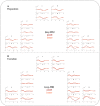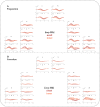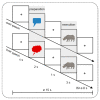Inner versus Overt Speech Production: Does This Make a Difference in the Developing Brain?
- PMID: 33291489
- PMCID: PMC7762104
- DOI: 10.3390/brainsci10120939
Inner versus Overt Speech Production: Does This Make a Difference in the Developing Brain?
Abstract
Studies in adults showed differential neural processing between overt and inner speech. So far, it is unclear whether inner and overt speech are processed differentially in children. The present study examines the pre-activation of the speech network in order to disentangle domain-general executive control from linguistic control of inner and overt speech production in 6- to 7-year-olds by simultaneously applying electroencephalography (EEG) and functional near-infrared spectroscopy (fNIRS). Children underwent a picture-naming task in which the pure preparation of a subsequent speech production and the actual execution of speech can be differentiated. The preparation phase does not represent speech per se but it resembles the setting up of the language production network. Only the fNIRS revealed a larger activation for overt, compared to inner, speech over bilateral prefrontal to parietal regions during the preparation phase. Findings suggest that the children's brain can prepare the subsequent speech production. The preparation for overt and inner speech requires different domain-general executive control. In contrast to adults, the children´s brain did not show differences between inner and overt speech when a concrete linguistic content occurs and a concrete execution is required. This might indicate that domain-specific executive control processes are still under development.
Keywords: event-related brain potentials (ERPs); functional near-infrared spectroscopy (fNIRS); inner speech production; overt speech production; preparation of speech production.
Conflict of interest statement
The authors declare no conflict of interest.
Figures









Similar articles
-
The Brain Differentially Prepares Inner and Overt Speech Production: Electrophysiological and Vascular Evidence.Brain Sci. 2020 Mar 4;10(3):148. doi: 10.3390/brainsci10030148. Brain Sci. 2020. PMID: 32143405 Free PMC article.
-
The use of electroencephalography in language production research: a review.Front Psychol. 2011 Sep 1;2:208. doi: 10.3389/fpsyg.2011.00208. eCollection 2011. Front Psychol. 2011. PMID: 21909333 Free PMC article.
-
The Neural Mechanisms of Private Speech in Second Language Learners' Oral Production: An fNIRS Study.Brain Sci. 2025 Apr 25;15(5):451. doi: 10.3390/brainsci15050451. Brain Sci. 2025. PMID: 40426622 Free PMC article.
-
A rostro-caudal axis for language in the frontal lobe: the role of executive control in speech production.Neurosci Biobehav Rev. 2014 Nov;47:431-44. doi: 10.1016/j.neubiorev.2014.09.008. Epub 2014 Oct 8. Neurosci Biobehav Rev. 2014. PMID: 25305636 Review.
-
Functional near-infrared spectroscopy for the assessment of speech related tasks.Brain Lang. 2012 May;121(2):90-109. doi: 10.1016/j.bandl.2011.03.005. Epub 2011 Apr 19. Brain Lang. 2012. PMID: 21507475 Review.
Cited by
-
Investigation of functional near-infrared spectroscopy signal quality and development of the hemodynamic phase correlation signal.Neurophotonics. 2022 Apr;9(2):025001. doi: 10.1117/1.NPh.9.2.025001. Epub 2022 May 18. Neurophotonics. 2022. PMID: 35599691 Free PMC article.
References
-
- Fernyhough C. Alien voices and inner dialogue: Towards a developmental account of auditory verbal hallucinations. New Ideas Psychol. 2004;22:49–68. doi: 10.1016/j.newideapsych.2004.09.001. - DOI
-
- Vygotsky L.S. In: The Collected Works of L.S. Vygotsky: Volume 1: Problems of General Psychology, Including the Volume Thinking and Speech. Rieber R.W., Carton A.S., editors. Springer; New York, NY, USA: 1987. Cognition and Language: A Series in Psycholinguistics, The Collected Works of L.S. Vygotsky. Volume 1–6.
-
- Morin A. In: Inner Speech. 2nd ed. Hirstein W., editor. Elsevier; Amsterdam, The Netherlands: 2012.
LinkOut - more resources
Full Text Sources

